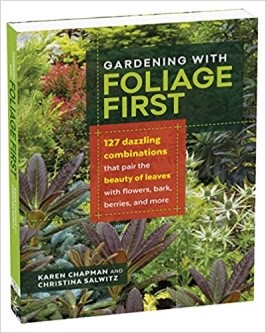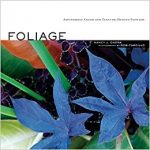Foliage: Subtle Beauty — Long Term Impact
By George Graine, Fairfax Master Gardener
“If you really want to draw close to your garden, you must remember first of all that you are dealing with a being that lives and dies; like the human body, with its poor flesh, its illnesses at time repugnant. One must not always see it dressed up for a ball, manicured and immaculate.” –Fernand Lequenne
 Why leaves? After all they do not do much for your garden. Oh really! Let’s reconsider how leaves (foliage) will help inspire you because they really do have color, texture and form. Indeed, foliage plants have numerous possibilities in all of these characteristics and you can have color, color, color. The next time you visit a garden center, box store or horticultural park take a longer look at the plants. What do you see beyond the flower? Is there any need to explain the texture and form when it is right in front of your eyes? It is easy to understand the reluctance to consider the importance of foliage because every spring, garden catalogs emphatically emphasize (unrealistic) close-up color photos of flowers. When foliage is provided, it is usually secondary or stuck in a section of ground covers, ferns and ornamental grasses. All of these plant families have their place in landscape design, but there are so many more plants that exhibit great foliage beauty alongside flowers that eventually will fade. So what is left? Of course, it is the foliage. Perhaps you are seduced by all of this color when you visit the garden center as it is first and foremost in your mind. Growers and retailers are keenly aware of this. In other words, how does an interesting green plant compare to the must-have colorful plant du jour?
Why leaves? After all they do not do much for your garden. Oh really! Let’s reconsider how leaves (foliage) will help inspire you because they really do have color, texture and form. Indeed, foliage plants have numerous possibilities in all of these characteristics and you can have color, color, color. The next time you visit a garden center, box store or horticultural park take a longer look at the plants. What do you see beyond the flower? Is there any need to explain the texture and form when it is right in front of your eyes? It is easy to understand the reluctance to consider the importance of foliage because every spring, garden catalogs emphatically emphasize (unrealistic) close-up color photos of flowers. When foliage is provided, it is usually secondary or stuck in a section of ground covers, ferns and ornamental grasses. All of these plant families have their place in landscape design, but there are so many more plants that exhibit great foliage beauty alongside flowers that eventually will fade. So what is left? Of course, it is the foliage. Perhaps you are seduced by all of this color when you visit the garden center as it is first and foremost in your mind. Growers and retailers are keenly aware of this. In other words, how does an interesting green plant compare to the must-have colorful plant du jour?
The key to a new book Gardening with Foliage First: 127 Dazzling Combinations That Pair the Beauty of Leaves with Flowers, Bark, Berries and More by Karen Chapman and Christina Salwitz (Timber Press, 2017) emphasizes a different aspect of landscape design and how it will “interact” with flowering plants. Think about that for a moment. It is not horticultural heresy to carefully consider foliage because a well-designed landscape practically demands this reversal of thought, that is, from flowers first and foliage as an afterthought. Consider this book as an excellent resource for winter reading (actually any time) and as an action plan for the start of the next growing season in spring. With this in mind, Chapman and Salwitz explain how to integrate flowers and other design elements so that you will enhance your landscape in a way that you might otherwise not achieve. The authors also advocate four-season gardening. For example, consider the winter garden after all the leaves have fallen. A landscape can be beautiful given the “right” plant selection.
In just 10 introductory pages you will come to realize and understand how to make a different design connection and how your own inspiration can work harmoniously. Foliage First differs from other similar books (see end of this article) in that it divides each year into two main chapters starting with spring–summer followed by fall–winter. Each section has detailed design descriptions accompanied with helpful color photos so that you will have a clear word–picture explanation for more than ten dozen plant combinations. The plant combinations for spring–summer include those for bright locations (52) and shaded spaces (34). Likewise, the fall–winter combinations, although lesser in design suggestions, should be enough to satisfy gardeners of any stripe (tyro to advanced). Sunny areas include 28 displays and shady locations have 13 designs. This adds up to 127 plant combinations as noted in the Foliage First book sub-title. By the way, it is a hoot to read how each plant combination is given a name. A few random examples: Twist and Shout, Picture of Innocence, Midas Touch, Ice Cream Sandwich and Whipped Cream or Lemon Mousse. With this sort of humor how can this book not be considered to find out if Foliage First is all that the authors advocate.
In summary, Foliage First is a book that incorporates not only the beauty of leaves but will inspire you to rethink foliage in an extremely different way aside from the noxious chores of the inevitable end-of-season cleanup. If you have not given much thought to foliage, perhaps now it is time to reconsider this extraordinary opportunity to enhance your landscape. If you agree with the premise that foliage is important to landscape design, then you owe it to yourself to add to your newly acquired knowledge and see how some other books describe the virtues of foliage.
Resources
Foliage: Astonishing Color and Texture Beyond Flowers by Nancy J. Ondra (Storey Publishing, 2007)
Consider the Leaf: Foliage in Garden Design
Variegated Trees & Shrubs: The Illustrated Encyclopedia by Ronald Houtman (Timber Press, 2004)
 |
 |
 |